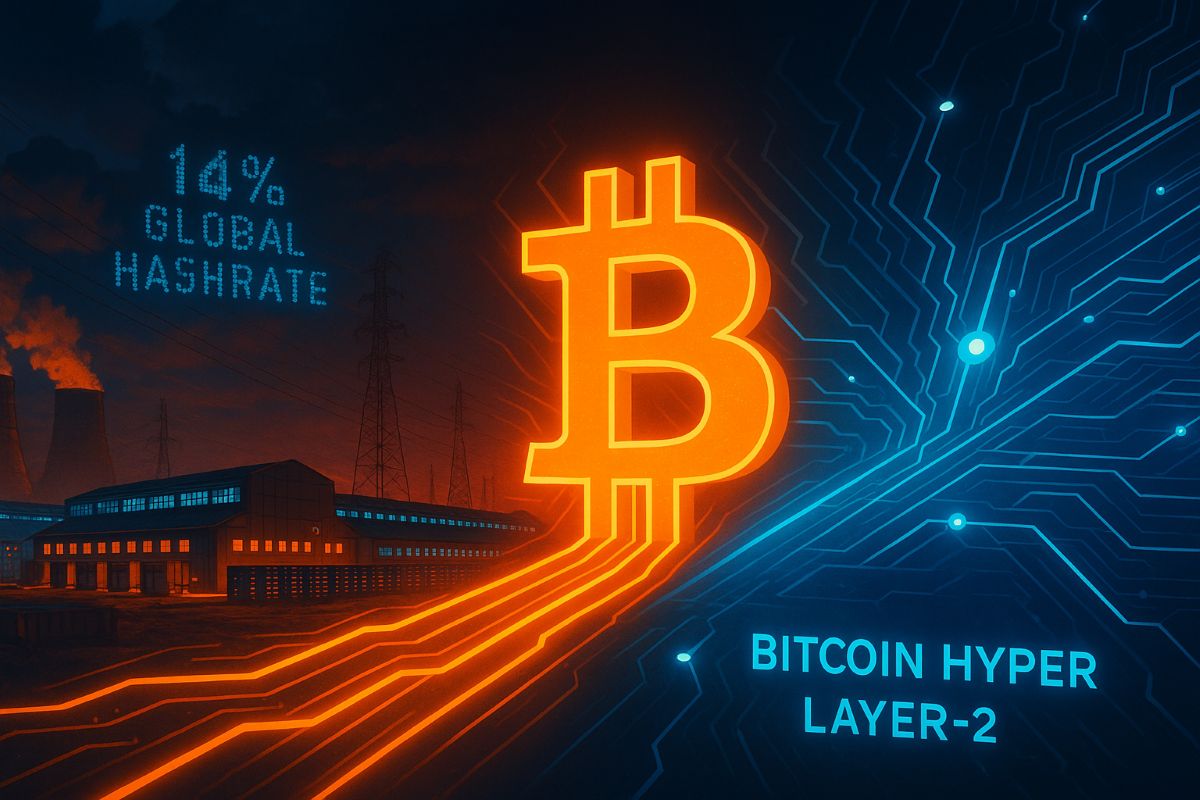Quick Facts:
- ➡️ China has quietly regained roughly 14% of global Bitcoin hashrate, reflecting sustained institutional commitment despite the ongoing mining ban.
- ➡️ Industrial-scale mining driven by low-cost power and unused data centers strengthens Bitcoin’s position as a resilient macro asset rather than a speculative fad.
- ➡️ Bitcoin’s base layer continues to face throughput, fee, and programmability constraints, fueling demand for secure and scalable Layer-2 infrastructure.
- ➡️ Bitcoin Hyper’s SVM-powered Bitcoin Layer-2 architecture delivers high-speed smart contracts and DeFi, targeting execution performance that can exceed Solana-class systems.
China’s Bitcoin mining sector is quietly roaring back to life.
Despite the 2021 nationwide ban, new data from Luxor and Hashrate Index shows China now accounts for roughly 14% of global Bitcoin hashrate, reclaiming the No. 3 spot behind the U.S. and Russia.
Miners are tapping cheap surplus power and idle data centers in regions like Xinjiang, turning ‘banned’ mining into a large, underground industry again.
Rig sales have surged, and enforcement appears softer where the economic upside is strongest.
That kind of build-out doesn’t happen unless serious capital believes Bitcoin’s long-term price is going much higher. Industrial-scale players don’t chase a few percentage points; they deploy hardware, negotiate power contracts, and model multi‑year upside.
You’re watching a country that once drove miners out quietly re‑accumulate exposure.
For everyday investors, front-running that institutional conviction through spot $BTC alone is capital-intensive. This is where Bitcoin Hyper ($HYPER) comes in.
As a Bitcoin Layer 2 that aims to deliver Solana‑level performance on top of $BTC, it offers a more leveraged, narrative-driven way to ride renewed Bitcoin momentum with far smaller upfront capital. It’s also one of the best crypto presales of 2025.
Why a 14% Chinese Hashrate Share Supercharges the Bitcoin Trade
China’s return to a 14% hashrate share underscores how resilient miner economics are when prices trend higher, and energy remains cheap.
It also concentrates even more industrial firepower behind Bitcoin’s security budget, reinforcing the thesis that $BTC is evolving into a long-term, quasi‑sovereign asset rather than a passing fad.
At the same time, this renewed mining push highlights Bitcoin’s core limitation for you as a user: the base layer is secured by massive global hashrate, but it still processes only about 7 transactions per second, with confirmation times measured in minutes and unpredictable fee spikes during peak demand.
Competing Bitcoin Layer 2 solutions, from rollup-style designs to sidechains and state channels, are racing to patch that gap.
Projects like Rootstock, Stacks, and various Bitcoin rollup experiments all try to add programmability or cheaper blockspace while inheriting Bitcoin’s security guarantees to different degrees.
What is Bitcoin Hyper? It’s the newest competitor among Bitcoin Layer 2s, positioning itself as one of several emerging high-performance infrastructure bets aiming to create a faster, cheaper Bitcoin payments network.
How Bitcoin Hyper Turns Mining Conviction into Programmable Throughput
Where Bitcoin Hyper breaks from the pack is its architecture. It markets itself as the first Bitcoin Layer 2 integrating the Solana Virtual Machine (SVM), aiming to deliver even faster performance than Solana on a modular stack: Bitcoin L1 for settlement, a real‑time SVM execution layer on L2, and a decentralized canonical bridge for $BTC transfers.
Extremely low‑latency SVM execution means developers can build swaps, lending markets, NFT platforms, and gaming projects with sub‑second finality and low fees, while still anchoring state periodically to Bitcoin.
That directly targets Bitcoin’s biggest pain points: slow base‑layer settlement, high fees during congestion, and the lack of native smart contract support for complex DeFi or gaming workloads.
The market is already paying attention. The Bitcoin Hyper presale has raised $28.6M, with tokens currently priced at $0.013345, suggesting investors see asymmetry in a Bitcoin‑secured, Solana‑style execution environment.
Smart money is moving too: purchases include buys of $500K and $379K. To join in, learn how to buy Bitcoin Hyper.
For holders looking beyond simple $BTC exposure, $HYPER includes presale staking with high‑APY rewards (currently 40%) and a 7‑day vesting period for presale stakers to keep incentives aligned with network growth.
Our price forecast for $HYPER shows the token could reach $0.20 by the end of 2026, amounting to some 1,400% gains.
If you believe China’s mining resurgence is a tell that the next Bitcoin expansion phase is underway, exploring the $HYPER presale is one way to express that conviction with leverage.
Join the $HYPER presale today.
This article is for informational purposes only and does not constitute financial, investment, or trading advice; always do your own research.
Authored by Bogdan Patru for Bitcoinist — https://bitcoinist.com/china-bitcoin-mining-14-percent-boosts-bitcoin-hyper-demand

Editorial Process for bitcoinist is centered on delivering thoroughly researched, accurate, and unbiased content. We uphold strict sourcing standards, and each page undergoes diligent review by our team of top technology experts and seasoned editors. This process ensures the integrity, relevance, and value of our content for our readers.

